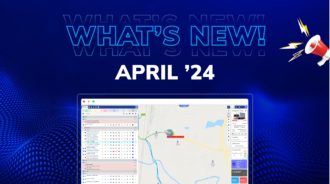In the ever-evolving landscape of fleet management, driver monitoring solutions are emerging as a pivotal component. These innovative systems not only enhance the safety and efficiency of fleet operations but also integrate seamlessly with advanced expense management features in fleet management software. In this blog, we’ll explore the myriad benefits of implementing driver monitoring solutions, a trend gaining significant traction in the industry.
What are Driver Monitoring Solutions?
Driver monitoring solutions are advanced systems used in vehicle fleet management to ensure the safety and efficiency of drivers and vehicles. These systems use a combination of technologies like cameras, sensors, and artificial intelligence to monitor various aspects of driver behavior and vehicle operation in real-time. The primary focus of these solutions is to track indicators such as:
- Driver Fatigue and Alertness: Monitoring signs of drowsiness or inattention, often through facial recognition or eye-tracking technology.
- Driving Behavior: Assessing patterns like speeding, harsh braking, abrupt cornering, or rapid acceleration.
- Distraction Detection: Identifying instances where the driver is not focused on the road, such as using a mobile phone or other distractions.
- Health Monitoring: In some advanced systems, monitoring the driver’s health indicators, like heart rate, to detect any signs of medical distress.
Why Driver Monitoring Solutions are Needed in Fleet Management
- Enhancing Safety: The primary reason for implementing driver monitoring in fleet management is to increase safety. By identifying risky behaviors, fleet managers can intervene to prevent accidents. For example, if a driver is detected as drowsy, the system can alert the driver or notify the fleet manager to take action.
- Compliance with Regulations: Many regions have strict regulations regarding driving hours, rest periods, and safe driving practices. Driver monitoring solutions help ensure compliance with these laws, reducing the risk of legal issues and penalties.
- Reducing Operational Costs: Unsafe driving behaviors can lead to increased fuel consumption, vehicle wear and tear, and accidents, all of which result in higher operational costs. Monitoring drivers helps in promoting safer, more efficient driving practices, thus saving money in the long run.
- Improving Fleet Efficiency: Data collected from driver monitoring can be used to optimize routes, reduce idle times, and enhance overall fleet performance. This leads to more efficient operations and better service delivery.
- Insurance Benefits: Many insurance companies offer reduced premiums for fleets that implement safety measures like driver monitoring, recognizing the reduced risk of accidents and claims.
- Driver Training and Development: The insights gained from monitoring can be used to identify areas where drivers may need additional training or coaching, leading to a more skilled and professional workforce.
- Enhanced Reputation: By ensuring safe driving practices and compliance with regulations, companies can improve their public image and reputation, which is crucial for business growth and customer trust.
Driver monitoring solutions are a vital component of modern fleet management, offering numerous benefits in terms of safety, compliance, cost reduction, and overall operational efficiency. These systems represent a proactive approach to managing the challenges associated with managing a fleet of vehicles and drivers.
1. Enhancing Safety Through Vigilance
Proactive Accident Prevention
Driver monitoring solutions are crucial for identifying risky behaviors such as drowsiness, distraction, or impaired driving. By detecting these behaviors early, the system can alert the fleet manager or the driver, enabling immediate intervention. This proactive approach can significantly reduce the likelihood of accidents, protecting not only the drivers but also other road users.
Real-Time Feedback for Drivers
These systems often provide immediate feedback to drivers, alerting them to potentially hazardous behaviors. This ongoing guidance helps drivers to self-correct in real-time, reducing the likelihood of accidents. For instance, if a driver is frequently braking harshly, the system can alert them to adopt smoother driving techniques.
2. Boosting Efficiency and Productivity
Optimizing Fleet Performance
Driver monitoring solutions offer valuable data on driving patterns, allowing for the optimization of routes and reduction of idle times. This leads to a more efficient use of vehicles, ensuring timely deliveries and improved customer satisfaction. Fleet managers can use this data to plan better routes that avoid traffic congestion or hazardous conditions.
Reducing Fuel Consumption
Monitoring systems can identify driving behaviors that lead to excessive fuel consumption, such as over-speeding or prolonged idling. By correcting these behaviors, fleets can achieve significant fuel savings. This is not only cost-effective but also environmentally friendly.
3. Integrating with Expense Management
Streamlining Expense Tracking
Driver monitoring systems provide accurate data that can be used for tracking and allocating expenses related to vehicle use, maintenance, and fuel consumption. This integration with expense management features in fleet management software simplifies financial management and ensures accurate expense tracking.
Enhancing Budgeting and Forecasting
The integration of real-time driving data into expense management systems allows for precise budgeting and forecasting. This leads to more informed financial decisions, enabling fleet managers to better control and optimize fleet expenses.
4. Compliance and Reporting
Adhering to Regulations
Driver monitoring solutions ensure compliance with road safety regulations and working hour limits. This not only helps in avoiding legal penalties but also promotes a culture of safety and responsibility within the fleet.
Simplified Reporting Process
The data from these systems can be easily compiled into comprehensive reports for compliance and internal record-keeping. This automation of the reporting process saves time and resources, making compliance easier and more efficient.
5. Promoting a Culture of Safety and Responsibility
Encouraging Responsible Driving
Continuous monitoring and feedback encourage a culture of responsibility among drivers, leading to safer driving practices. This can also improve the overall public image of the company.
Enhancing Driver Training
The data collected can be used to identify specific training needs for drivers. Customized training programs based on actual driving data are more effective and directly address areas needing improvement.
Driver monitoring solutions in fleet management offer a range of benefits from enhancing safety to optimizing efficiency and reducing costs. Their integration with advanced fleet management software, particularly in expense management, provides a holistic approach to fleet management. As these technologies continue to evolve, their role in shaping the future of fleet management becomes increasingly significant, marking a shift towards more proactive, data-driven, and safety-focused fleet operations.
Conclusion
The integration of driver monitoring solutions in fleet management is not just a trend; it’s a significant step towards safer, more efficient, and cost-effective fleet operations. These systems, when combined with advanced expense management features, offer a comprehensive solution that addresses many challenges faced by fleet managers today. As we continue to embrace technological advancements, the role of driver monitoring solutions in shaping the future of fleet management cannot be overstated.
Incorporating these systems is more than just a technological upgrade; it’s a commitment to safety, efficiency, and financial prudence. The benefits are clear, and as the industry evolves, these systems will undoubtedly become a standard in fleet management practices.



